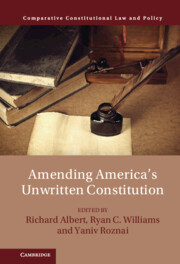Book contents
- Amending America’s Unwritten Constitution
- Comparative Constitutional Law and Policy
- Amending America’s Unwritten Constitution
- Copyright page
- Contents
- Contributors
- Acknowledgments
- Introduction A Return to Constitutional Basics: Amendment, Constitution, and Writtenness
- 1 The Unwritten Constitutions of the United States
- 2 Enumerating Amendments
- 3 Change Is the Only Constant: Unwritten Amendments and the Courts
- 4 The Role of the People in Unwritten Amendments
- 5 Unwritten State Constitutions? In Search of Constitutional Communities
- 6 State Constitutions and the Interaction between Formal Amendment and Unwritten Commitments
- 7 The Drive for a National Popular Vote for the Presidency: A Case Study in Amending the Unwritten Constitution
- 8 The Trump Presidency, the Racial Realignment, and the Future of Constitutional Norms
- 9 Amending an Unwritten Constitution: Comparative Perspectives
- 10 The Unwritten Foundations of (All) Written Constitutions
- Index
6 - State Constitutions and the Interaction between Formal Amendment and Unwritten Commitments
Published online by Cambridge University Press: 13 October 2022
- Amending America’s Unwritten Constitution
- Comparative Constitutional Law and Policy
- Amending America’s Unwritten Constitution
- Copyright page
- Contents
- Contributors
- Acknowledgments
- Introduction A Return to Constitutional Basics: Amendment, Constitution, and Writtenness
- 1 The Unwritten Constitutions of the United States
- 2 Enumerating Amendments
- 3 Change Is the Only Constant: Unwritten Amendments and the Courts
- 4 The Role of the People in Unwritten Amendments
- 5 Unwritten State Constitutions? In Search of Constitutional Communities
- 6 State Constitutions and the Interaction between Formal Amendment and Unwritten Commitments
- 7 The Drive for a National Popular Vote for the Presidency: A Case Study in Amending the Unwritten Constitution
- 8 The Trump Presidency, the Racial Realignment, and the Future of Constitutional Norms
- 9 Amending an Unwritten Constitution: Comparative Perspectives
- 10 The Unwritten Foundations of (All) Written Constitutions
- Index
Summary
The literature on America’s unwritten constitution is rigorous and compelling, but it tends to focus almost entirely on how the federal Constitution has evolved through informal processes. In this chapter, I argue that our understanding of America’s unwritten constitution would be improved if we broadened the inquiry to include state constitutions. Unlike the federal Constitution, where Article V’s near-impossible amendment rules force essentially all reforms into informal pathways, the states have designed amendment rules and facilitated political cultures that encourage frequent formal amendment of constitutional text. Consequently, to the extent that unwritten constitutional commitments exist in the states, they are not the product of necessity, and they may shed new light on how constitutional rules evolve. In this chapter, I show that in various significant areas, states have indeed fostered robust unwritten constitutions and that state constitutionalism is characterized by a complex, competitive, and highly contextual interaction between codified and unwritten constitutional commitments.
Keywords
- Type
- Chapter
- Information
- Amending America's Unwritten Constitution , pp. 121 - 146Publisher: Cambridge University PressPrint publication year: 2022



